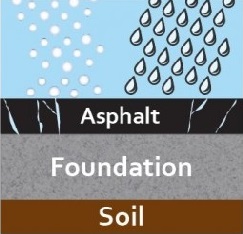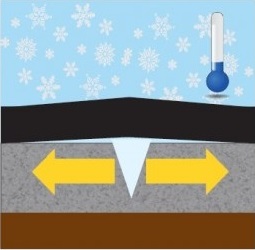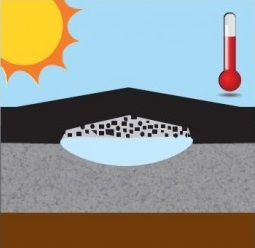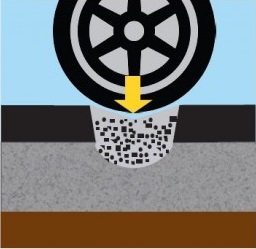Roadway maintenance
Our Roadway Maintenance and Equipment group is responsible for the maintenance of 1,690 kilometres of roadway in Kelowna. Highway 97 (Harvey Avenue) and Highway 33 are maintained by the Provincial Ministry of Transportation & Infrastructure.
Roads are monitored by our Pavement Management System. Kelowna roads are tested regularly for surface condition, roughness and strength, and our system identifies and prioritizes roads that require maintenance. We regularly inspect existing infrastructure – including roadways, sidewalks, bicycle networks and bridges – to identify areas that require maintenance and to ensure that facilities perform adequately for their design lifespan. All bridges are inspected on a yearly basis and repaired as needed.
While road work can be inconvenient, it’s necessary to manage long-term costs and extend the life of Kelowna's roads. Crews aim to schedule and coordinate road work in a way that has the least impact on neighbouring residents, commuters and visitors. Most work happens during the Spring and Summer seasons, as the warm, dry weather is ideal for road paving. Crews also ensure that they communicate with emergency services so that roads remain accessible when needed.
To learn more about the future of Kelowna's roads, check out the 20 year Roadway Network Plan.
Road repairs
Crack sealing extends road life by keeping moisture that will eventually cause asphalt failures from getting into the road base. Roads are inspected and sealed for cracks by priority.
Repairing potholes is an important and affordable method of maintaining our roads. We encourage the public to report potholes online to help keep roads safe. Potholes located on provincial highways, including Highway 97 and Highway 33, are the responsibility of the Province Ministry of Transportation. The following chart illustrates how a pothole forms:
 |
| A pothole begins to form when water and moisture seep into the foundation layer and start to soften it |
 |
| As the temperature drops, the water freezes and expands, pushing the asphalt up while opening up a larger space in the foundation for more water to collect |
 |
| As the sun melts and dries up the underlying water, the asphalt above starts to buckle and crack while also being exposed to further wear from vehicle traffic |
 |
| Eventually the compromised asphalt will collapse into the hole left by the melting ice. Passing traffic will also kick up material, digging the hole deeper |
Potholes form on asphalt road surfaces due to seasonal freezing and thawing. The changing weather from season to season leads to the formation of potholes, which is why they tend to be more prominent in the Winter and Spring when the weather fluctuates.
It’s estimated that a single road maintenance crew repairs over 3,000 potholes over the course of the year, with approximately 1,500 repairs in the winter. To repair a pothole, crews will remove the old asphalt, dry the area (using a torch in the winter) and fill the hole with new asphalt. The area is then repacked.
Asphalt used for repairs in winter months is recycled from City projects conducted in the Summer, Spring and Fall months. Repairs take place from Nov. 1 until April 1.
We produce our own hot mix asphalt using an Ashton asphalt recycler, which heats up old asphalt and rejuvenates it to a usable state again.
Road shoulders are inspected and repaired if warranted.
Gravel lanes and roads are graded and dust controlled once a year in the Spring; additional services are performed if warranted.
All ditches are inspected and repaired if warranted. We have a detailed GPS based ditch inventory and City Council has adopted a policy for dealing with ditches that have been filled in.
Based on the prioritization method outlined in the Pedestrian and Bicycle Master Plan, new sidewalks are constructed throughout the Spring, Summer, and Fall months.
All sidewalks are inspected in the Spring and repaired as needed.
Regulatory signs such as “Stop” and “Yield” are replaced or repaired as soon as notification is received. All other signs are replaced or repaired as soon as possible.
The Roadway Maintenance and Equipment department is responsible for the maintenance and programming of signalized intersections, pedestrian activated intersections and the solar powered crosswalk warning flashers.
Road treatments
Mill and fill extends the life of existing roadways and creates a smooth ride by eliminating the effects of tire ruts and asphalt movement that occur over years of use.
This is accomplished by removing approximately 50 millimetres of existing asphalt through a process called cold milling, then replacing it with a suitable depth of new hot mix asphalt. The 50 mm of milled asphalt that is removed is recycled and used as a surface treatment on rural roads and lane ways throughout the city.
The asphalt overlay program involves the application of 50 mm of new asphalt on top of the existing roadway, creating a new driving surface and extending the life of the road. This process is typically performed on rural streets with no curbs and gutters.
Micro-surfacing preserves and extends the life of the road surface by sealing, filling ruts and providing skid resistance. Micro-surfacing involves the application of a dense graded aggregate, mixed with asphalt emulsions, water and mineral fillers, to the road surface. Once applied, it takes approximately four to five hours to cure, creating a new stable surface that is resistant to rutting in the summer and cracking in the winter.
Road reclamation creates a new road by grinding the roadway’s existing asphalt and gravel base, then mixing it with new gravel. This mixture is placed on the roadbed, graded and shaped prior to receiving two inches of new asphalt. Road reclamation is typically performed on rural streets with no curbs and gutters.
From April until November, hot mix asphalt is purchased and used for asphalt repairs on all city roads. During the winter months when hot mix asphalt is unavailable, old asphalt that has been collected during the summer is recycled and used for asphalt repairs.
All road markings are re-painted once a year. On roads where there is significant road wear, for example arterials and connectors, centre and lane lines will be painted twice per year. Crosswalks are re-painted once per year and as needed throughout the year.
The part of the roadway system serving as the principal network for through traffic flow. The routes connect areas of principal traffic generation and important rural highways entering the city (e.g. Springfield Road, Glenmore Road and Rutland Road).
The part of the roadway system servicing traffic between major and local roadways (e.g. Sutherland Avenue, Valley Road and Baron Road).
Roadways used primarily for direct access to residential, commercial, industrial or other bordering property (e.g. typical residential roads found in most neighbourhoods).



